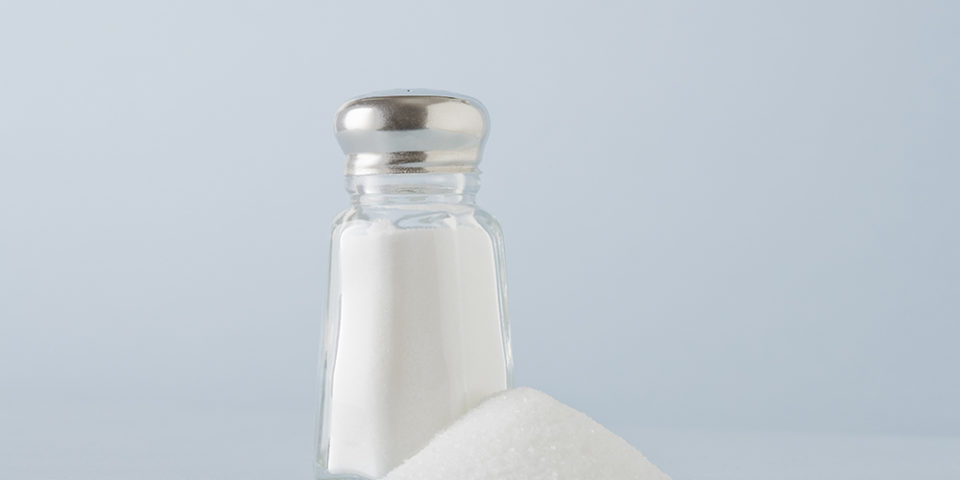How does salt affect hypertension?
Hypertension, or high blood pressure, is a problem faced by nearly half of adults in the United States. People diagnosed with hypertension are often told by their doctors to cut out not just excess sodium but to eat a lower-sodium diet overall, but how does salt affect hypertension?
Lisa Akly, RDN, explained what causes hypertension and what you need to know about the link between salt intake and high blood pressure.
What causes hypertension?
“We don’t know the exact cause of hypertension,” said Akly. “However, we do know the most common risk factors associated with developing the condition.”
Hypertension happens when your arteries are put under stress that forces the heart to work harder, with greater pressure, to push the same volume of blood through your body. Over time, this higher pressure can do serious, significant damage to your heart.
Risk factors for high blood pressure include:
- Being overweight or obese
- Inadequate exercise or physical activity
- Smoking or vaping
- Excessive alcohol or caffeine use on a regular basis
- Age, as our blood vessels lose some elasticity as we grow older
- Before age 64, men are more likely to develop hypertension
- At 65+, women are more likely to be diagnosed with high blood pressure
- Chronic kidney disease
- Certain medications, including NSAIDs
- High sodium intake
How does salt affect hypertension?
“We do believe that salt intake has a significant effect on blood pressure,” said Akly. “When you eat salt, it pulls water out from our cells into the surrounding bloodstream, creating that higher pressure when the arteries can’t meet the need to expand.”
Chronically elevated blood pressure that goes untreated not only causes damage to your blood vessels over time, but it can put strain on your heart and kidneys as well.
Does reducing salt intake actually help lower high blood pressure?
“Reducing your salt intake is one of the best first steps you can take to help combat high blood pressure,” said Akly. “According to the CDC, nearly three-quarters of the sodium in the average American diet comes just from processed food or restaurant foods. Even just choosing to cook more at home from fresh ingredients is likely to make a big difference in your daily sodium intake.”
One great way to shift to a lower-sodium diet without feeling like you’re depriving yourself of the foods you love is to look for low-sodium “copycat” recipes of those restaurant foods you’ve relied on in the past.
When cooking at home, cut the amount of salt in the recipe in half. Test out sodium-free seasoning blends that add plenty of flavor without affecting your salt intake. Double the amount of veggies in the recipe. Buy fresh or frozen vegetables without added sauces or seasoning. Rinsing canned vegetables can remove up to 40% of the sodium. When purchasing packed foods, check the sodium percentage on the nutritional label before you put the item in your cart. Five percent or less is considered low in sodium, while 20% or more is considered high in sodium.
Is Himalayan salt, pink salt or other kinds of salt any healthier than table salt?
When it comes to nutrition and hypertension, all salt is salt. All of it raises the amount of sodium in your body and can negatively affect your blood pressure.
Different kinds of salt can add different flavor notes to your food, but they don’t do much at all for the nutritional value.
Does the DASH diet help lower blood pressure?
“The DASH diet is really more about changing the overall way you eat than having to follow a very strict, restrictive diet,” said Akly. “It helps to lower blood pressure because it focuses so much on heart healthy foods.”
DASH stands for Dietary Approaches to Stop Hypertension. It’s focused on changing the foods you eat to those that have a higher amount of nutritional benefits and are known to be good for your heart. Suggested foods include whole grains, fresh fruits and vegetables and lean or plant-based proteins in lieu of red meat. The foods recommended by the DASH diet tend to be rich in potassium, calcium and magnesium, all of which help to control blood pressure and impact heart health.
While switching to the DASH diet might initially feel overwhelming, there are lots of recipes online and cookbooks available that specifically collect those DASH-approved recipes. But once you have the basics down, it’s easy to stick to the DASH pattern of eating without feeling like you have to choose just from those recipes.
What is the safe level of sodium daily for people with hypertension?
The American Heart Association recommends for most adults no more than 2,300 milligrams per day, or about one full teaspoon worth of salt. While 2,300 mg might seem like a high number, processed foods often have very high sodium levels and it’s easy to be over that number long before lunch.
Ideally, adults would stick to the more ideal number of 1,500 mg a day, which is considered a beneficial target for those facing hypertension. That’s why it’s so important to read nutrition labels and track how much salt you’re adding into your foods, as well as trying to lessen the amount of time you eat out at restaurants.
Can eating too much salt in one day raise blood pressure to harmful levels?
“There’s really no one answer to this question, because not everyone is sensitive to salt,” said Akly. “Eating too much salt at any one time can certainly raise blood pressure. Although the rise might be temporary, if you are already struggling with hypertension, that rise could be harmful.”
Since most processed foods contain high amounts of sodium, and restaurant food is often heavily salted to create a stronger flavor, eating fresh food cooked at home using a heart-healthy eating pattern is really the best way to limit your sodium intake.
Find a cardiologist you trust
We make it easier to get the care your heart needs, with cardiologists located near you.
Learn More

